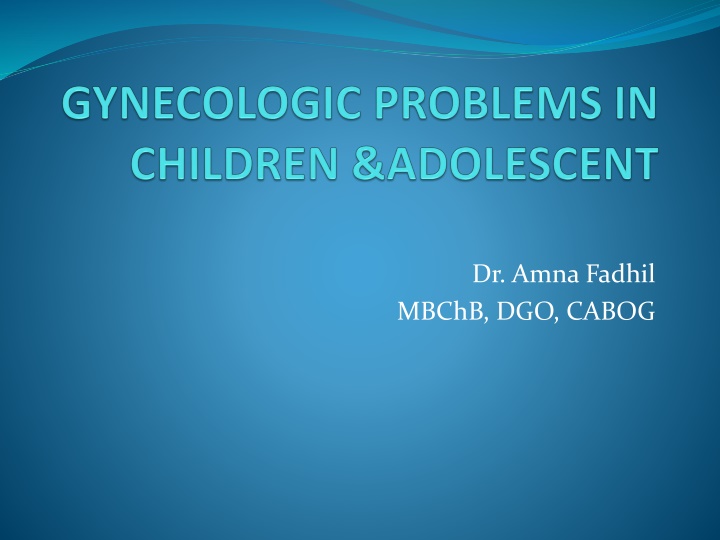
Gynecological Issues in Prepubertal Girls: Causes and Management
Learn about labial adhesion, vulvovaginitis, and menstrual irregularities in prepubertal girls. Understand the causes, symptoms, and management options for these common gynecological problems. Explore anatomical variations and treatment approaches. Enhance your knowledge to provide effective care for young patients.
Download Presentation

Please find below an Image/Link to download the presentation.
The content on the website is provided AS IS for your information and personal use only. It may not be sold, licensed, or shared on other websites without obtaining consent from the author. If you encounter any issues during the download, it is possible that the publisher has removed the file from their server.
You are allowed to download the files provided on this website for personal or commercial use, subject to the condition that they are used lawfully. All files are the property of their respective owners.
The content on the website is provided AS IS for your information and personal use only. It may not be sold, licensed, or shared on other websites without obtaining consent from the author.
E N D
Presentation Transcript
Dr. Amna Fadhil MBChB, DGO, CABOG
Learning objectives: At the end of this lecture, the student should be able to: 1.Describe the labial adhesion and its management. 2. Recognize vulvovaginitiscauses and its management. 3.List causes of menstrual irregularities. 4. Identify the gynecologic neoplasms including ovarian tumors and its management.
Anatomy In the neonate, sonographically, the uterus measures 3.5cm*1.5 cm, the cervix is larger than the fundus, ovarian volume small less than 1cm3. During childhood, the uterus measures 2.5 to 4 cm, cervix and fundus being equal size.
Labial adhesion when the labia minora have adhered together. Causes: unknown , loww estrogen level. *treatment If asymptomatic, no treatment is necessary If extensive adhesion with urinary symptoms : estrogen cream twice daily for 2 weeks, If separation is not easily accomplished, surgical operation under local or general anesthesia
Vulvovaginitis This is one of the most common gynecological problems of prepubertal girls. Causes : Poor vaginal hygiene, foregin body. Short distance from anus to vagina Lack labial fat pad and labial hair Low level of estrogen Chronic disease and altered immune system Sexual abuse
Symptoms Vaginal discharge Pruritusor soreness in external genitalia. Painful urination. Vaginal bleeding.
Signs: Vulva becomes edematous and red or even ulcerated. Vaginal inspection reveals congested epithelium . foreign body may be detected. The examination may be done under anesthesia Investigations: exclude DM , swab for bacterial culture either by gram stain or culture, to identify the causative organism
Treatment Vulvar hygiene Sitz baths are very helpful in relieving symptoms To keep the local area dry. To wear cotton undergarments. Medication To reduce the overgrowth of pathogenic bacteria, Amoxicillin is effective. Trichomoniasis is treated by metronidazole Monilial infection is treated by local application of clotrimazole 1 percent cream. Topical cream, baking soda in warm water If itching is sever 2.5% topical hydrocortisone ointment twice daily for one week.
Vaginal bleeding Neonates may present with vaginal bleeding due to withdrawal of maternal estrogen Local causes
Genital trauma The prepubertal vulva is less protective from blunt injury due to lack of labial fat pad and they are more active so , this increase risk of trauma . Sexual abuse should be considered in many cases of trauma
Ovarian mass Symptoms of ovarian mass lump in the lower abdomen, acute pain abdomen or, at times, with retention of urine.
Investigations: Ultrasound is an invaluable tool in the diagnosis of ovarian mass. CT, MRI may be needed in few cases of pelvic mass with uncertain diagnosis. Pre-operative work-up needs tumor markers estimation (serum CA125, fetoprotein, hCG, inhibition, CEA and testosterone) in these adolescent girls.
Ovarian cyst treatment: A suspected functional cyst (6 8 cm) may be observed for 3 6 months. Unilocular functional cysts usually resolve spontaneously. Surgical therapy is needed in cases where there are symptoms, masses that fail to resolve or masses with solid or multilocularappearance on ultrasound. Laparoscopy is usually done when an adnexal mass appears to be benign. However, prompt laparotomy should be done when there are evidences of malignancy.





















